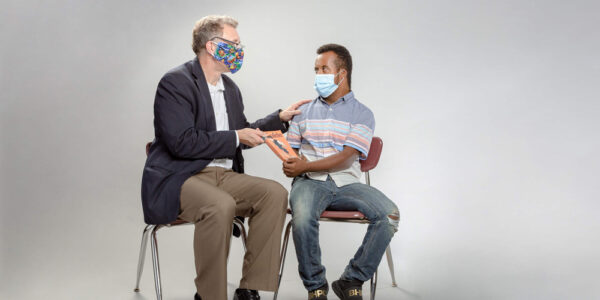Many church members and leaders make the mistake of assuming no disabled members attend their church. However, in 2018, the Centers for Disease Control (CDC) in the United States reported that approximately one in four American adults live with a disability. That adds up to about 61 million people in the entire country.
Globally, about one billion people live with a disability, of which depression is the most common. So, statistically, it is almost certain that several people with disabilities attend any church. As Charlotte Thoms, coordinator of North American Division (NAD) Disabilities Ministries, puts it, the Bible says we are all part of God’s body and we’re called to pursue every nation. Hence, it is our duty to pursue and not turn our backs on the disabled community.
Larry Evans, assistant to the General Conference president for Deaf and Possibility Ministries, agrees and explains why it is important to reach the disabled community.
“There’s no way that Jesus will come when the people He spent so much time ministering to [during] his ministry are neglected,” he says about the lack of ministry for disabled individuals.
Thoms points out that more than three-fourths of Jesus’ miracles on earth involved disabled people. Such people are present in today’s church, and even though we may not be able to heal them, they deserve to be treated with the same love and patience that Jesus showed them.
So what can the church do to encourage participation and leadership from disabled individuals? Here are several useful tips compiled from conversations with Larry Evans, Charlotte Thoms, and Fawn Scherencel.
Embrace the Change
Evans and Thoms believe that a genuine desire for change is the first step in being more inclusive toward disabled individuals. Evans said he trusts that every single church has compassionate members who can play a role in including disabled brothers and sisters. Thoms said she believes that many people tend to be reluctant to include those with disabilities because they fear saying or doing something considered offensive to the disabled community. At the same time, Fawn Scherencel, a congenital amputee and principal of Hinsdale Adventist Academy in Hinsdale, Illinois, states that she appreciates those who approach her with genuine intentions.
“I would much rather someone ask me a sincere, candid question about my disability than to just be afraid to ask,” she said.
Once those fears are lifted, members can begin to better understand the community and their culture. Evans emphasizes the importance of understanding the culture before making changes. He believes trying to work with someone without understanding them is essentially pointless.
See the Possibilities
Evans said he sees a common pattern of identifying disabled individuals solely through their disability. It’s important to remember that disabled individuals have their own passions, interests, and unique personalities and should be treated as such.
Churches can try to counteract this stigma by establishing a sense of identity and purpose that goes far beyond their disability. Evans said he believes giving individuals actual roles in the church leadership to promote fellowship can help establish their sense of purpose in the local church.
Another tendency people have when participating in disability ministries is to be concerned that they will have to work for the disabled person. Evans explains that this can be condescending, as it implies someone has to do all the work for them. Instead, members should look forward to working with the disabled community.
He said it’s important to learn to see the possibility in people before the disability. It is something that will help you build the community while also building your understanding.
Create an Action Plan
Taking action is one of the steps of Evans’s “3 A’s Strategy” — Awareness, Acceptance, Action — to reach the disabled. First, members need to become aware of the characteristics and needs of the disabled community while simultaneously accepting them for how God made them. Once members do this and have a clearer perception of the community, they can begin to create a plan of action. An action plan helps identify those with disabilities, addresses their specific needs, and proposes accommodation plans to ultimately create opportunities for them.
Whether it be a blind person who needs a Braille Bible or a disabled person who needs a ramp to access the audio-visual stage, the members should now be prepared to address the need. You can consider creating a committee or nominating a leader to take charge of disability ministries.
Start at the Grassroots
Don’t be scared if you feel as though not many people are interested or as if your actions are not impactful enough. Evans describes Possibility Ministries as a grassroots movement that grows from the ground up. According to Thoms, before the General Conference even had a disabilities ministry (which began in 1995), the local church was the grassroots of this movement.
She encourages members to remember that God promises to be there even if there are only two or three. No group is too small; no action is too small, so we should get comfortable taking baby steps.
Use Your Resources
Evans acknowledges that even though Disability Ministries is a grassroots movement, divisions and unions play a role in supporting conferences and local churches. Your division may help you by providing resources not available at the local level. Interpreter training, workshops, informational handbooks, and recently published virtual learning material in response to the ongoing pandemic are all resources that are sure to help your grassroots movement get going.
Useful resources for the disabled community or those interested in disability ministries include:
- General Conference Adventist Possibility Ministries
- North American Division Disabilities Ministries
- Three Angels Deaf Ministries
- Christian Record Services for the Blind
The original version of this story was posted by the Lake Union Herald.



